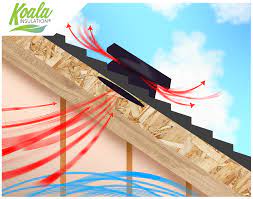Solar Attic Fans: How Ventilation and Insulation Work Together

In the hot summer months, attics worldwide turn into mini saunas as heat rises from the home and gets trapped in the attic alongside moisture that collects due to high humidity levels.
If you have a well-insulated attic, you might think that this phenomenon isn't anything to worry about, as the insulation should keep the heat out of your main living area while trapping your air conditioning inside.
However, excessive heat and humidity in your attic can do a lot more damage than you think, from making insulation less effective to actively damaging your attic and roofing. This can lead to costly repairs and skyrocketing air conditioning bills.
Thankfully, there is a simple fix to this problem, ventilation. With proper ventilation, your attic will stay cooler, your insulation will be more effective, and you'll be able to enjoy comfortable temperatures year-round.
Our pick for one of the best ways to ventilate your attic. Solar attic fans. Keep reading to find out why solar attic fans are one of our favorite picks for attic ventilation.
What is a solar attic fan?
Solar attic fans are ventilation fans that are powered by built-in solar panels. The fans pull heat and moisture out of your attic and vent it outdoors, continually reducing the buildup of heat and humidity in your home.
What makes solar attic fans so popular is that they require no additional electricity to function. They draw all of their power straight from the sun, making them a cost-effective and eco-friendly alternative to traditional attic fans.
The benefits of a solar attic fan
So, if you choose to install a solar attic fan, what benefits can you expect? Let's take a look at the specific benefits that installing a solar attic fan can bring.
It removes excess moisture
Excess moisture in your attic can have disastrous consequences, and if you live in a warm, humid environment, moisture can accumulate quickly in a hot attic. The accumulation of moisture can lead to various issues, some small, some much larger, and costly.
The most common issue with moisture buildup is mold. Black mold and mildew love a warm, humid environment, and once they begin to take root, they can spread throughout your attic and affect the air quality of your home. Mold and mildew can cause severe allergic reactions in some people and may lead to respiratory irritation and breathing issues in others.
And because most people don't spend a lot of time in their attics, mold can go unnoticed for months or even years, and by the time it's caught, it can cost a lot of money to have it removed.
One of the larger issues that moisture buildup can cause is structural damage. When wood is exposed to moisture for many years, it can rot or warp, and this can cost thousands of dollars to repair.
With a solar attic fan, your attic is continually vented of moisture, preventing the development of costly damages brought on by excess moisture buildup.
It can extend the life of your roof
When temperatures rise in your attic, it can cause damage to one of the most important elements of your home, your roof. Your roof protects your home from the elements, but when it's subjected to an excessively hot attic, it can warp or even crack. Roof damage can be exceedingly expensive to correct, so venting excess heat with a solar attic fan can be crucial to extending the life of your roof and preventing costly repairs.
It can improve the efficiency of your air conditioning
When an attic gets too hot, some of that excess heat can penetrate your existing insulation and begin to heat the rest of your home. As your home gets warmer, your air conditioner will have to work harder to keep up. This can drive up your cooling costs significantly. An attic fan vents this excess heat and will help keep your home cooler overall, meaning your AC won't have to work as hard. And with a solar attic fan, because it generates its own power through its solar panels, it won't add to your electric bill. That's a cost-saving win-win.
Are solar attic fans expensive?
Solar attic fans cost a little bit more than traditional roof vents. However, they offer numerous cost-saving advantages that can more than offset the initial cost of the device. They are more powerful than a traditional wind-powered vent, which means they will vent more heat and thus drive down cooling costs more.
They also work year-round, whereas a wind-powered vent won't work on a hot summer day without a breeze. This continuous operation paired with zero operating costs thanks to the built-in power generation means that solar attic fans end up saving you more money in the long run than the cost of installing them.
Does Koala Insulation offer solar attic fans?
At Koala Insulation, our experts are well-versed in all kinds of attic insulation and ventilation. If you're looking to install a solar attic fan or want a full assessment of your home's insulation to identify problem areas, we've got you covered.
Our experts will arrive with state-of-the-art equipment to thoroughly inspect your attic or home and identify areas in need of repair or improvement. They will provide a detailed assessment of the current conditions of your space and use their years of experience to design solutions that fit your home and budget.
Find Your Location


Get a quote


